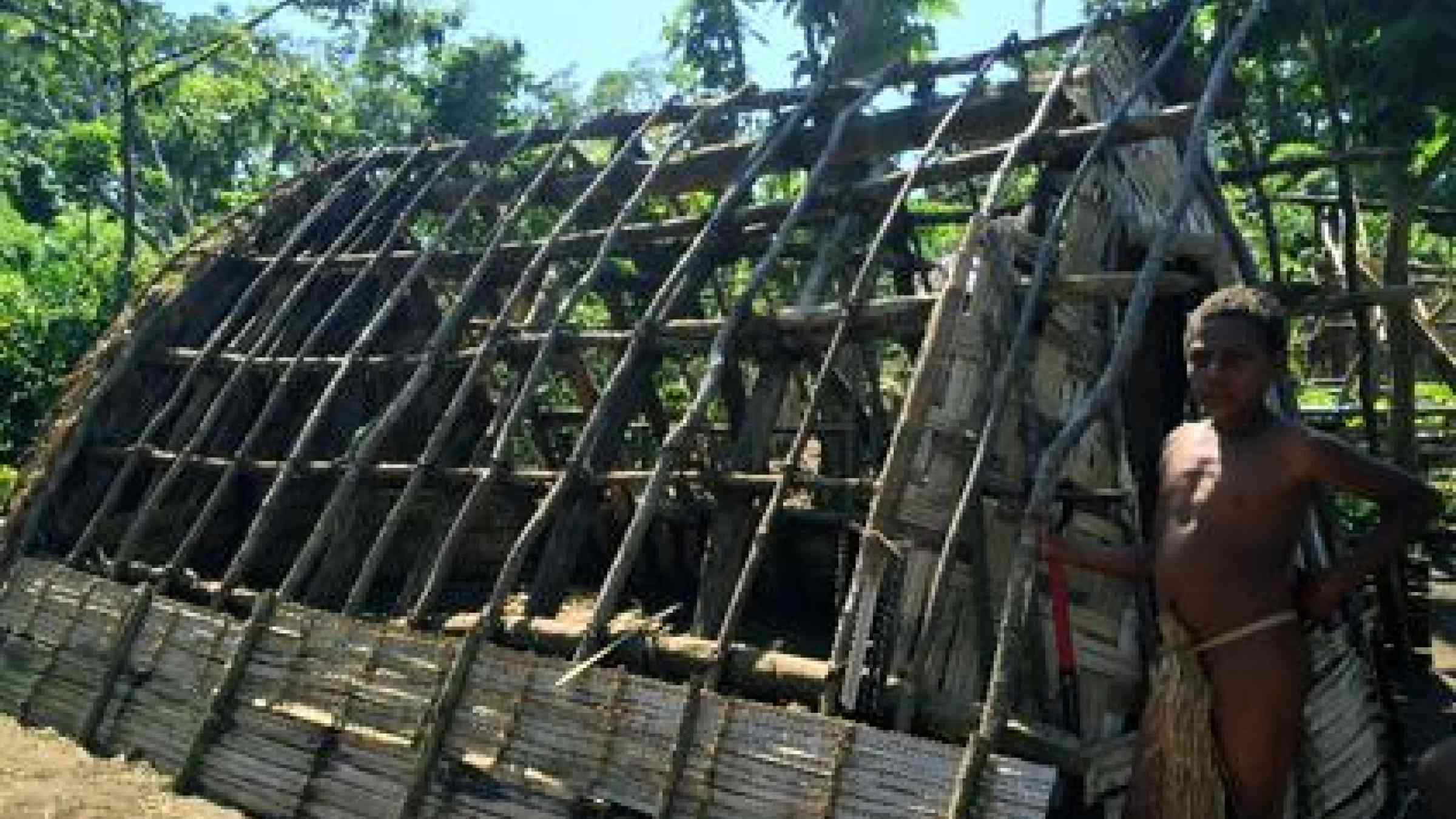Local knowledge saves lives in Vanuatu

VANUATU, 22 September 2015 - The Pacific Region has a wealth of traditional knowledge for disaster risk reduction. It is rarely advertised or documented, but passed on by word of mouth from generation to generation. One striking example came to light after one of the worst cyclones this year.
“When the cyclone came, our community was huddled inside the cyclone shelter, gripping onto the posts and praying. Inside the cyclone shelter it was very quiet, and when the cyclone went away we came out again. None of us were harmed“, according to a statement from residents of Yakel Village.
Category 5 Tropical Cyclone Pam hit Vanuatu from 12 to 14 March this year, passing through the
archipelago from North to South. The economic damage is estimated at US$ 449 million, almost two-thirds of the countries’ GDP, according to the Vanuatu Government.
Tanna Island was one of the islands worst affected by the cyclone.
“The wind started getting very bad around midnight on Friday, and continued until 10 the next morning. It was like a nightmare with people running around but unable to see“, says Daniel Ben, a resident of Tanna Island.
Sabrina Wako, operating an accommodation service by the beach, says “It took out all of our crops growing on the ground. After half a year, today I am finally able to harvest the first watermelon and I feel very happy”.
Five people were killed on the island, and the local community believes the death toll could have been much higher.
Charlie Lawat, operating a transport service on the island, says that four of the casualties were caused by “modern” material. “Two ladies were hiding in a church when the wall made of concrete blocks came falling down and crushed them. The wall was not reinforced with iron bars. The third person was trying to lift rubble off from the fourth when an iron roof came flying into his head. They were all killed by modern buildings,” he said.
One reason for the low number of casualties may be due to the traditional community cyclone shelters called nimaleten in the local dialect. The roof of the nimaleten characteristically slopes down all the way to the ground, making it difficult for the wind to gain a hold and blow the roof off.
According to a description in Christian Coiffer’s book, Traditional Architecture in Vanuatu, the nimaleten is built of wood, creepers, palm, and pandanus leaves:
“After the site has been cleared, three forked posts are knocked (up to a meter) deep into the ground, 2-50 m apart. … These long thin poles are joined together by cross poles, parallel with the ridge-pole and also tied with fibrous strings from various plants: Nolaou-liyao, Nouhil, Nameuhameuh. … All that remains to be done is to cover the whole with coconut-palm (kamek) leaf or pandanus plaques (noumankiou).”
Daniel observed: “Until Pam, local people had been preferring concrete, iron roofs, and nails because they are so easy to use. The vines used for traditional cyclone shelters take time to prepare. They need to be harvested from deep in the forest, heated close to the fire for several hours, then left in the ocean overnight for several days before they can be used. With nails it’s ‘bang’, and finished just like that. But then again, the corrugated iron roofs nailed on just flew off in the wind.
“Now that we know traditional materials work very well, more people –including myself– are looking to build traditional type buildings once again. The iron roofing is very expensive these days and hard to come by, but we can get the material for the traditional structure on our own lands“.
The UNESCO Office in Apia is supporting the region in preserving traditional architecture. UNESCO held a workshop in 2014 which laid the foundations for an action plan to revitalize indigenous architecture and traditional building skills. The workshop found that one of the tangible advantages to traditional buildings are their resilience to natural hazards.
The workshop also raised the issue that youths generally are not interested in traditional buildings, and that the challenge of designing them might “make them exciting to modern builders”. Lume Rural Training Centre and Care International are trying to encourage interest in that on Tanna Island.
Guiomar Grande of Care International is an architect from Spain supporting the recovery and rehabilitation process in Tanna Island. He pointed out a nimaleten built by Lume Rural Training Centre after the cyclone for a gathering which many local and international people attended.
He said: “We wanted to show that a combination of the traditional techniques with modern building techniques correctly applied creates an extremely durable structure. The posts for this structure go one meter into the ground, and have a horizontal cross-bar embedded. We have used nails in a “cross” configuration and bound that with vines, we have added a horizontal beam with metal straps. It would be very difficult to pull this structure off the ground!”
Care International is now developing a poster to showcase good practices mainly targeted at the younger generation to be included in community toolkits for distribution to the various villages on Tanna Island.
“There are variations of the structure across the many islands of Vanuatu, and each one is best suited for the environment it is on. The nimaleten here is beautiful and I hope the users are proud of it”, Guiomar says with a smile.
The Vanuatu Government’s Post-Disaster Needs Assessment after Tropical Cyclone Pam, stated that “The performance of nakamals (community buildings built using traditional material and techniques) during Tropical Cyclone Pam demonstrates why traditional knowledge remains relevant and must be preserved as part of living heritage and culture”.
The nimaleten-building Tanna Island has been nominated as a champion community in the Pacific for this year’s International Day for Disaster Risk Reduction, themed around traditional knowledge for disaster risk reduction.